Numerical Study on Heat Transfer Characteristics of Dielectric Fluid Immersion Cooling with Fin Structures for Lithium-Ion Batteries
Abstract
:1. Introduction
2. Numerical Method
2.1. Computational Geometry
2.2. Meshing
2.3. Governing Equation
2.4. Boundary Condition
| Time (s) | Heat Generation (W) | Time (s) | Heat Generation (W) |
|---|---|---|---|
| 0 | 4.91 | 432 | 4.75 |
| 71 | 4.89 | 504 | 4.75 |
| 144 | 4.84 | 576 | 4.72 |
| 216 | 4.82 | 648 | 5.57 |
| 287 | 4.73 | 720 | 6.29 |
| 360 | 4.66 |
| Specification | |
|---|---|
| Working fluid | E5-TM410 |
| Inlet working fluid temperature (°C) | 25 |
| Inlet working fluid volume flow meter (LPM) | 1, 2, 3, 4, 5 |
| Outlet pressure (Pa) | 0 |
| Wall slip condition | Non-slip |
| Heat source of battery (W) | Table 2 |
| Property | Battery | E5-TM410 |
|---|---|---|
| Density (kg/m3) | 2055.1 | 805 |
| Specific heat (J/kg∙K) | 1129.95 | 2100 |
| Thermal conductivity (W/m∙K) | 1.07 (radial) 19.03 (axial, tangential) | 0.14 |
| Viscosity (Pa∙s) | - | 0.015617- |
2.5. Data Reduction
3. Results and Discussion
3.1. Validation
3.2. Effect of Fin Structure
3.2.1. Temperature Performance
3.2.2. Nusselt Number and Pressure Drop
3.2.3. Performance Evaluation Criteria
3.3. Effect of Fin Dimension
3.3.1. Temperature Performance
3.3.2. Nusselt Number and Pressure Drop
3.3.3. Performance Evaluation Criteria
4. Conclusions
- (a)
- The maximum temperature, temperature difference and average temperature of the battery pack are lower for the triangular fin structure at each volume flow rate. The lowest maximum temperature of the battery pack is evaluated as 45.55 °C, 41.21 °C, 38.11 °C, 36.61 °C and 36.76 °C for triangular fin structure at volume flow rates of 1 LPM, 2 LPM, 3 LPM, 4 LPM and 5 LPM, respectively.
- (b)
- The triangular fin structure shows higher values of Nusselt number and pressure drop compared to other fin structures. The maximum Nusselt number of 589.41 and pressure drop of 241.98 Pa are evaluated for triangular fin structure at a volume flow rate of 5 LPM.
- (c)
- The PEC as the combined effect of Nusselt number and pressure drop is maximum for triangular fin structure at all volume flow rates. The triangular fin structure shows maximum PEC values of 1.156, 1.124, 1.094, 1.072 and 1.055 at volume flow rates of 1 LPM, 2 LPM, 3 LPM, 4 LPM and 5 LPM, respectively.
- (d)
- The triangular fin structure is recommended as the best fin structure to achieve the superior heat transfer characteristics of battery packs with dielectric fluid immersion cooling.
- (e)
- The triangular fin structure with an A/B ratio of 4.304 shows the lowest values of maximum temperature, temperature difference and average temperature as 35.07 °C, 7.95 °C and 31.76 °C, respectively, at 5 LPM volume flow rate.
- (f)
- The maximum Nusselt number of 662.50 is evaluated for triangular fin structure with an A/B ratio of 4.304 with a pressure drop of 264.33 Pa, which is lower than the maximum pressure drop of 293.91 Pa for triangular fin structure with an A/B ratio of 5.731 at 5 LPM volume flow rate.
- (g)
- The triangular fin structure with an A/B ratio of 4.304 shows maximum PEC at all volume flow rates from 1 LPM to 5 LPM with corresponding values of 1.082, 1.081, 1.072, 1.059 and 1.049. The A/B ratio of 4.304 is suggested as the optimum dimensions for triangular fin structure as it shows the enhanced heat transfer characteristics of battery pack with dielectric fluid immersion cooling.
Author Contributions
Funding
Institutional Review Board Statement
Informed Consent Statement
Data Availability Statement
Conflicts of Interest
References
- Qureshi, F.; Yusuf, M.; Pasha, A.A.; Khan, H.W.; Imteyaz, B.; Irshad, K. Sustainable and energy efficient hydrogen production via glycerol reforming techniques: A review. Int. J. Hydrogen Energy 2022, 47, 41397–41420. [Google Scholar] [CrossRef]
- Ali, A.; Al-Sulaiman, F.A.; Al-Duais, I.N.; Irshad, K.; Malik, M.Z.; Shafiullah, M.; Zahir, M.H.; Ali, H.M.; Malik, S.A. Renewable portfolio standard development assessment in the Kingdom of Saudi Arabia from the perspective of policy networks theory. Processes 2021, 9, 1123. [Google Scholar]
- Liu, H.; Wei, Z.; He, W.; Zhao, J. Thermal issues about Li-ion batteries and recent progress in battery thermal management systems: A review. Energy Convers. Manag. 2017, 150, 304–330. [Google Scholar] [CrossRef]
- Patil, M.S.; Panchal, S.; Kim, N.; Lee, M.Y. Cooling performance characteristics of 20 Ah lithium-ion pouch cell with cold plates along both surfaces. Energies 2018, 11, 2550. [Google Scholar] [CrossRef] [Green Version]
- Liu, H.; Xiao, Q.; Jin, Y.; Mu, Y.; Meng, J.; Zhang, T.; Jia, H.; Teodorescu, R. Improved LightGBM-Based Framework for Electric Vehicle Lithium-Ion Battery Remaining Useful Life Prediction Using Multi Health Indicators. Symmetry 2022, 14, 1584. [Google Scholar] [CrossRef]
- Lu, L.; Han, X.; Li, J.; Hua, J.; Ouyang, M. A review on the key issues for lithium-ion battery management in electric vehicles. J. Power Sources 2013, 226, 272–288. [Google Scholar] [CrossRef]
- Lee, M.Y.; Kim, N.; Seo, J.H.; Patil, M.S. Thermal abuse behavior of the LIR2450 micro coin cell battery having capacity of 120 mAh with internal short circuit by penetrating element. Symmetry 2020, 12, 246. [Google Scholar] [CrossRef] [Green Version]
- Zhang, X.; Li, Z.; Luo, L.; Fan, Y.; Du, Z. A review on thermal management of lithium-ion batteries for electric vehicles. Energy 2022, 238, 121652. [Google Scholar] [CrossRef]
- Jiaqiang, E.; Yi, F.; Li, W.; Zhang, B.; Zuo, H.; Wei, K.; Zhu, H.; Deng, Y. Effect analysis on heat dissipation performance enhancement of a lithium-ion-battery pack with heat pipe for central and southern regions in China. Energy 2021, 226, 120336. [Google Scholar]
- Liu, Z.; Huang, J.; Cao, M.; Jiang, G.; Yan, Q.; Hu, J. Experimental study on the thermal management of batteries based on the coupling of composite phase change materials and liquid cooling. Appl. Therm. Eng. 2021, 185, 116415. [Google Scholar] [CrossRef]
- Huang, Y.; Wei, C.; Fang, Y. Numerical investigation on optimal design of battery cooling plate for uneven heat generation conditions in electric vehicles. Appl. Therm. Eng. 2022, 211, 118476. [Google Scholar] [CrossRef]
- Zhao, G.; Wang, X.; Negnevitsky, M.; Li, C. An up-to-date review on the design improvement and optimization of the liquid-cooling battery thermal management system for electric vehicles. Appl. Therm. Eng. 2022, 219, 119626. [Google Scholar] [CrossRef]
- Akbarzadeh, M.; Kalogiannis, T.; Jaguemont, J.; Jin, L.; Behi, H.; Karimi, D.; Van Mierolo, J.; Berecibar, M. A comparative study between air cooling and liquid cooling thermal management systems for a high-energy lithium-ion battery module. Appl. Therm. Eng. 2021, 198, 117503. [Google Scholar] [CrossRef]
- Tan, X.; Lyu, P.; Fan, Y.; Rao, J.; Ouyang, K. Numerical investigation of the direct liquid cooling of a fast-charging lithium-ion battery pack in hydrofluoroether. Appl. Therm. Eng. 2021, 196, 117279. [Google Scholar] [CrossRef]
- Roe, C.; Feng, X.; White, G.; Li, R.; Wang, H.; Rui, X.; Li, C.; Zhang, F.; Null, V.; Parkes, M.; et al. Immersion cooling for lithium-ion batteries–A review. J. Power Sources 2022, 525, 231094. [Google Scholar] [CrossRef]
- Lin, J.; Liu, X.; Li, S.; Zhang, C.; Yang, S. A review on recent progress, challenges and perspective of battery thermal management system. Int. J. Heat Mass Transf. 2021, 167, 120834. [Google Scholar] [CrossRef]
- Gu, Q.; Li, G.; Wu, Z. The analysis on the battery thermal management system with composite phase change materials coupled air cooling and fins. J. Energy Storage 2022, 56, 105977. [Google Scholar] [CrossRef]
- Wu, S.; Lao, L.; Wu, L.; Liu, L.; Lin, C.; Zhang, Q. Effect analysis on integration efficiency and safety performance of a battery thermal management system based on direct contact liquid cooling. Appl. Therm. Eng. 2022, 201, 117788. [Google Scholar] [CrossRef]
- Sundin, D.W.; Sponholtz, S. Thermal management of Li-ion batteries with single-phase liquid immersion cooling. IEEE Open J. Veh. Technol. 2020, 1, 82–92. [Google Scholar] [CrossRef]
- Zhou, H.; Dai, C.; Liu, Y.; Fu, X.; Du, Y. Experimental investigation of battery thermal management and safety with heat pipe and immersion phase change liquid. J. Power Sources 2020, 473, 228545. [Google Scholar] [CrossRef]
- Li, Y.; Zhou, Z.; Hu, L.; Bai, M.; Gao, L.; Li, Y.; Liu, X.; Song, Y. Experimental studies of liquid immersion cooling for 18650 lithium-ion battery under different discharging conditions. Case Stud. Therm. Eng. 2022, 34, 102034. [Google Scholar] [CrossRef]
- Dubey, P.; Pulugundla, G.; Srouji, A.K. Direct comparison of immersion and cold-plate based cooling for au-tomotive Li-ion battery modules. Energies 2021, 14, 1259. [Google Scholar] [CrossRef]
- Li, Y.; Bai, M.; Zhou, Z.; Lv, J.; Hu, C.; Gao, L.; Peng, C.; Li, Y.; Li, Y.; Song, Y. Experimental Study of Liquid Immersion Cooling for Different Cylindrical Lithium-ion Batteries under Rapid Charging Conditions. Therm. Sci. Eng. Prog. 2022, 37, 101569. [Google Scholar] [CrossRef]
- Sahin, R.C.; Gocmen, S.; Cetkin, E. Thermal management system for air-cooled battery packs with flow-disturbing structures. J. Power Sources 2022, 551, 232214. [Google Scholar] [CrossRef]
- Cheng, L.; Garg, A.; Jishnu, A.K.; Gao, L. Surrogate based multi-objective design optimization of lithium-ion battery air-cooled system in electric vehicles. J. Energy Storage 2020, 31, 101645. [Google Scholar] [CrossRef]
- Zhuang, W.; Liu, Z.; Su, H.; Chen, G. An intelligent thermal management system for optimized lithium-ion battery pack. Appl. Therm. Eng. 2021, 189, 116767. [Google Scholar] [CrossRef]
- Patil, M.S.; Seo, J.H.; Lee, M.Y. A novel dielectric fluid immersion cooling technology for Li-ion battery thermal management. Energy Convers. Manag. 2021, 229, 113715. [Google Scholar] [CrossRef]
- Le, Q.; Shi, Q.; Liu, Q.; Yao, X.; Ju, X.; Xu, C. Numerical investigation on manifold immersion cooling scheme for lithium ion battery thermal management application. Int. J. Heat Mass Transf. 2022, 190, 122750. [Google Scholar] [CrossRef]
- Han, J.-W.; Hwang, S.-G.; Garud, K.S.; Lee, M.-S.; Lee, M.-Y. Numerical Study on Oil Cooling Performance of The Cylindrical Lithium-Ion Battery Pack with Flow Arrangement. J. Korea Acad. Ind. Coop. Soc. 2022, 23, 19–25. [Google Scholar] [CrossRef]
- Garud, K.S.; Lee, M.Y. Thermodynamic, environmental and economic analyses of photovoltaic/thermal-thermoelectric generator system using single and hybrid particle nanofluids. Energy 2022, 255, 124515. [Google Scholar] [CrossRef]
- Patil, M.S.; Seo, J.H.; Panchal, S.; Jee, S.W.; Lee, M.Y. Investigation on thermal performance of water-cooled Li-ion pouch cell and pack at high discharge rate with U-turn type microchannel cold plate. Int. J. Heat Mass Transf. 2020, 155, 119728. [Google Scholar] [CrossRef]
- Dong, F.; Cheng, Z.; Zhu, J.; Song, D.; Ni, J. Investigation and optimization on cooling performance of a novel double helix structure for cylindrical lithium-ion batteries. Appl. Therm. Eng. 2021, 189, 116758. [Google Scholar] [CrossRef]
- Garud, K.S.; Lee, M.Y. Numerical Investigations on Heat Transfer Characteristics of Single Particle and Hybrid Nanofluids in Uniformly Heated Tube. Symmetry 2021, 13, 876. [Google Scholar] [CrossRef]
- Han, J.W.; Garud, K.S.; Hwang, S.G.; Lee, M.Y. Experimental Study on Dielectric Fluid Immersion Cooling for Thermal Management of Lithium-Ion Battery. Symmetry 2022, 14, 2126. [Google Scholar] [CrossRef]
- Garud, K.S.; Hwang, S.G.; Han, J.W.; Lee, M.Y. Performance characteristics of the direct spray oil cooling system for a driving motor of an electric vehicle. Int. J. Heat Mass Transf. 2022, 196, 123228. [Google Scholar] [CrossRef]
- Garud, K.S.; Lee, M.Y. Grey relational based Taguchi analysis on heat transfer performances of direct oil spray cooling system for electric vehicle driving motor. Int. J. Heat Mass Transf. 2023, 201, 123596. [Google Scholar] [CrossRef]
- Hasan, M.I. Investigation of flow and heat transfer characteristics in micro pin fin heat sink with nanofluid. Appl. Therm. Eng. 2014, 63, 598–607. [Google Scholar] [CrossRef]
- Omri, M.; Smaoui, H.; Frechette, L.; Kolsi, L. A new microchannel heat exchanger configuration using CNT-nanofluid and allowing uniform temperature on the active wall. Case Stud. Therm. Eng. 2022, 32, 101866. [Google Scholar] [CrossRef]
- Patil, M.S.; Seo, J.H.; Panchal, S.; Lee, M.Y. Numerical study on sensitivity analysis of factors influencing liquid cooling with double cold-plate for lithium-ion pouch cell. Int. J. Energy Res. 2021, 45, 2533–2559. [Google Scholar] [CrossRef]


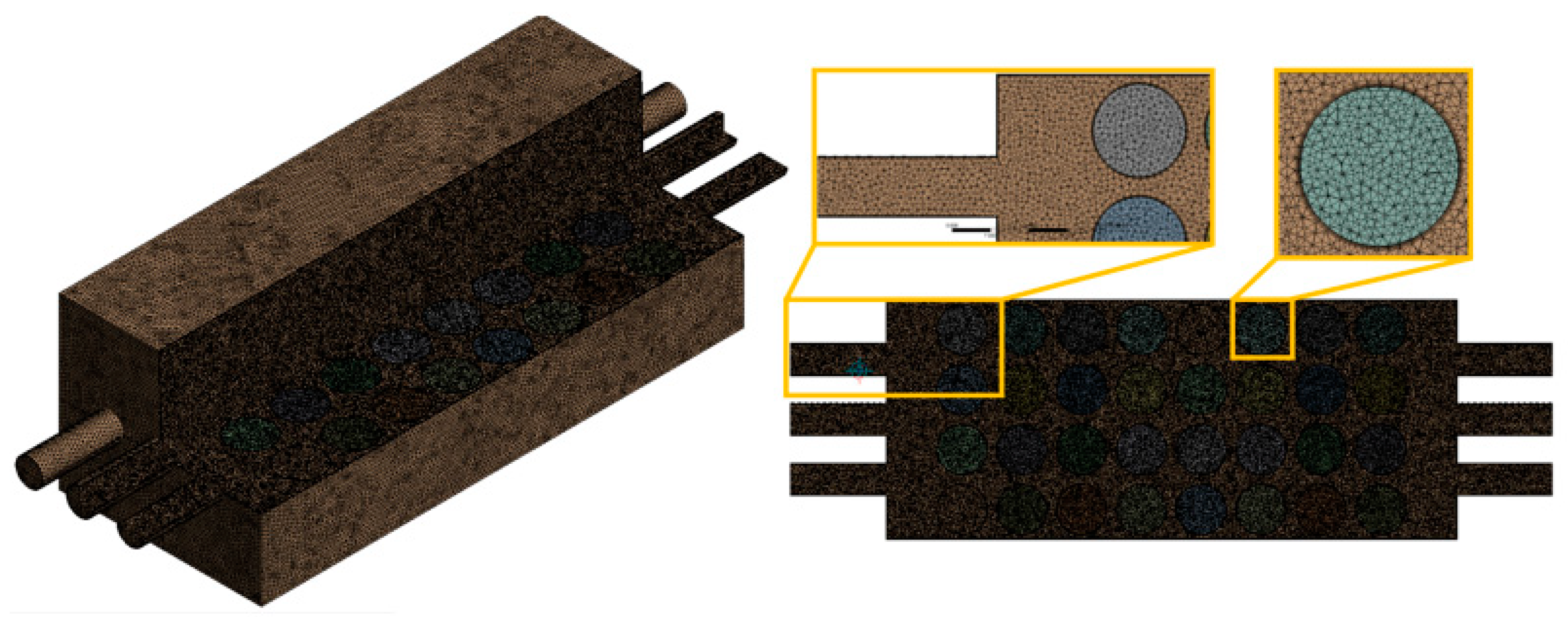

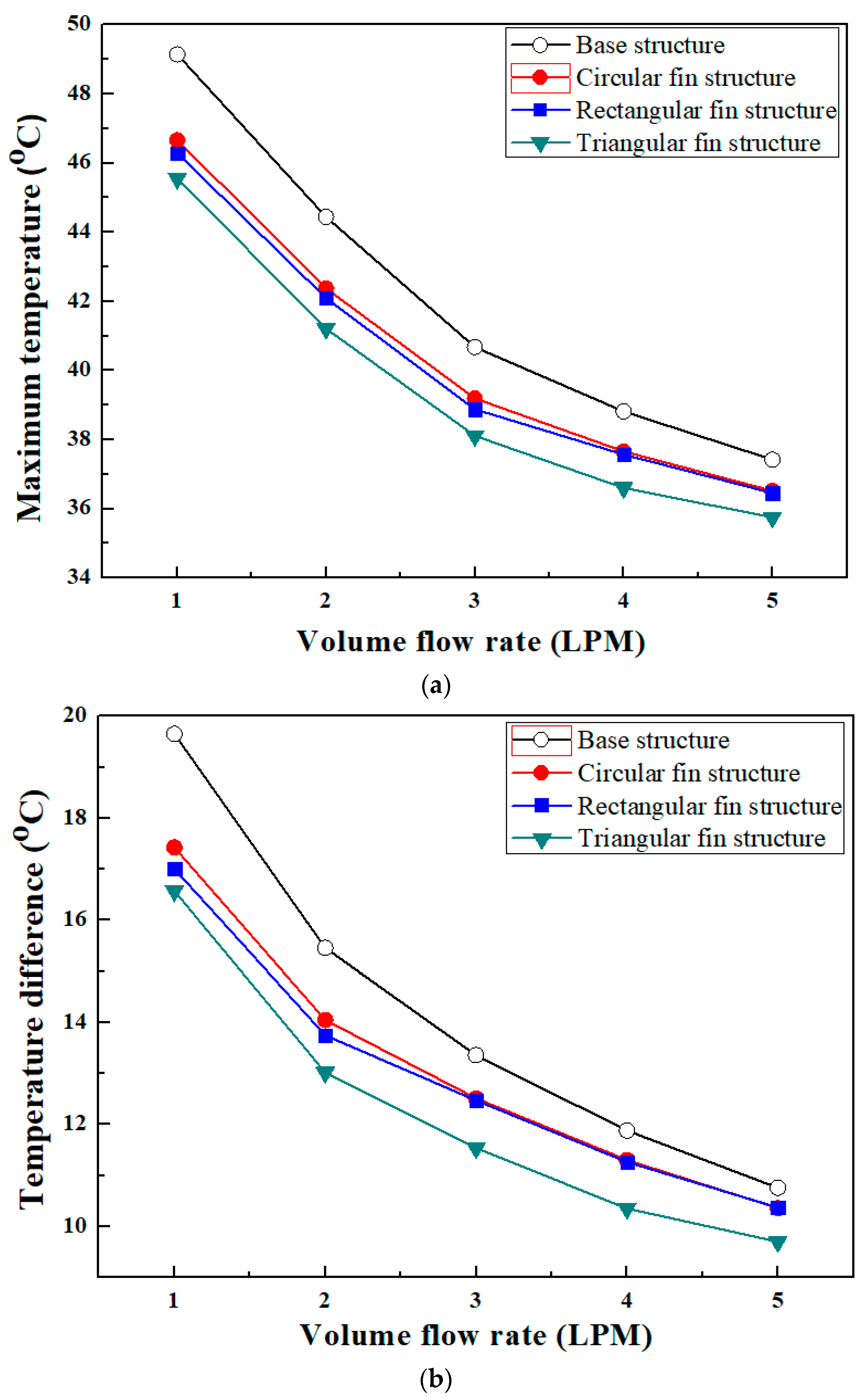
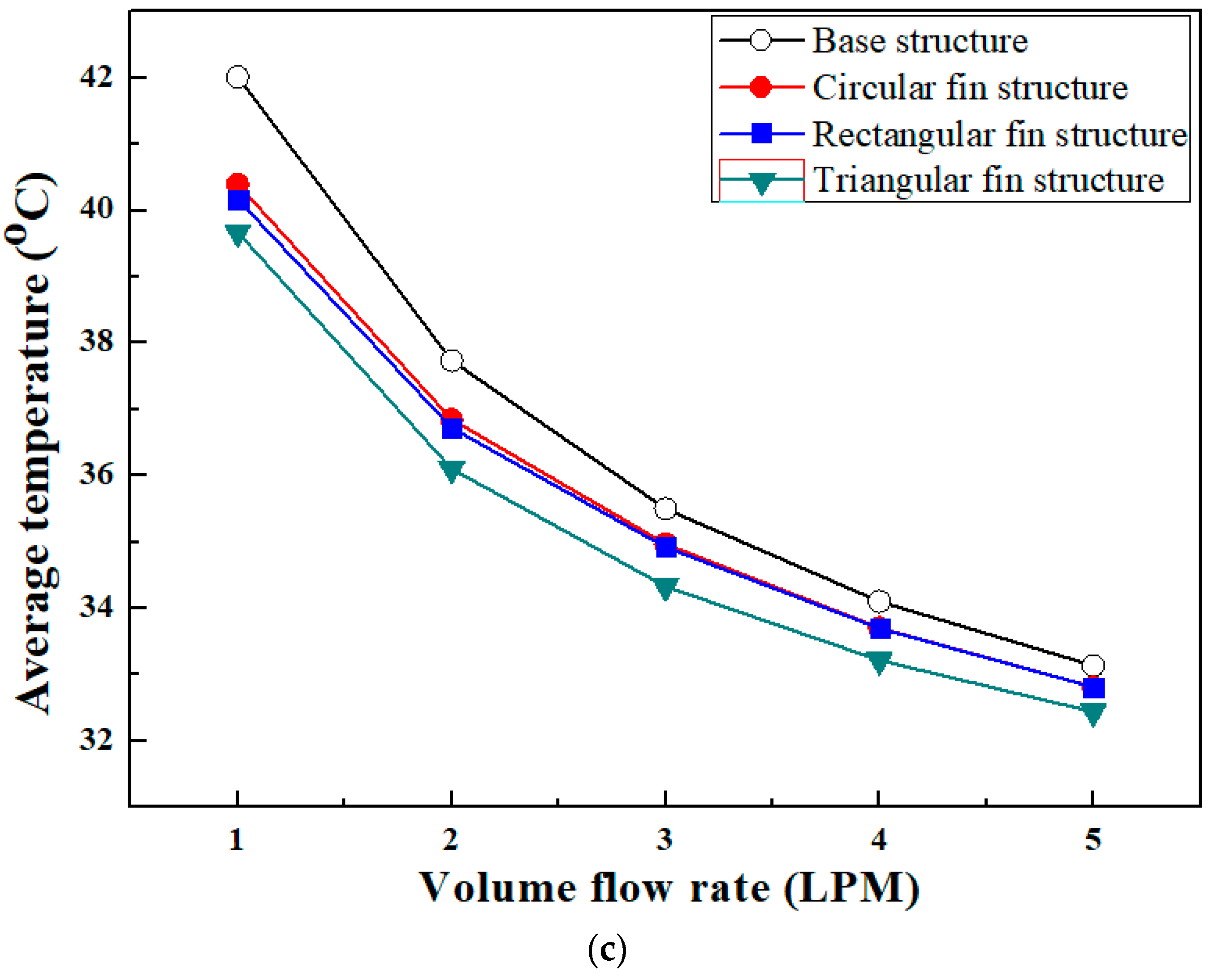
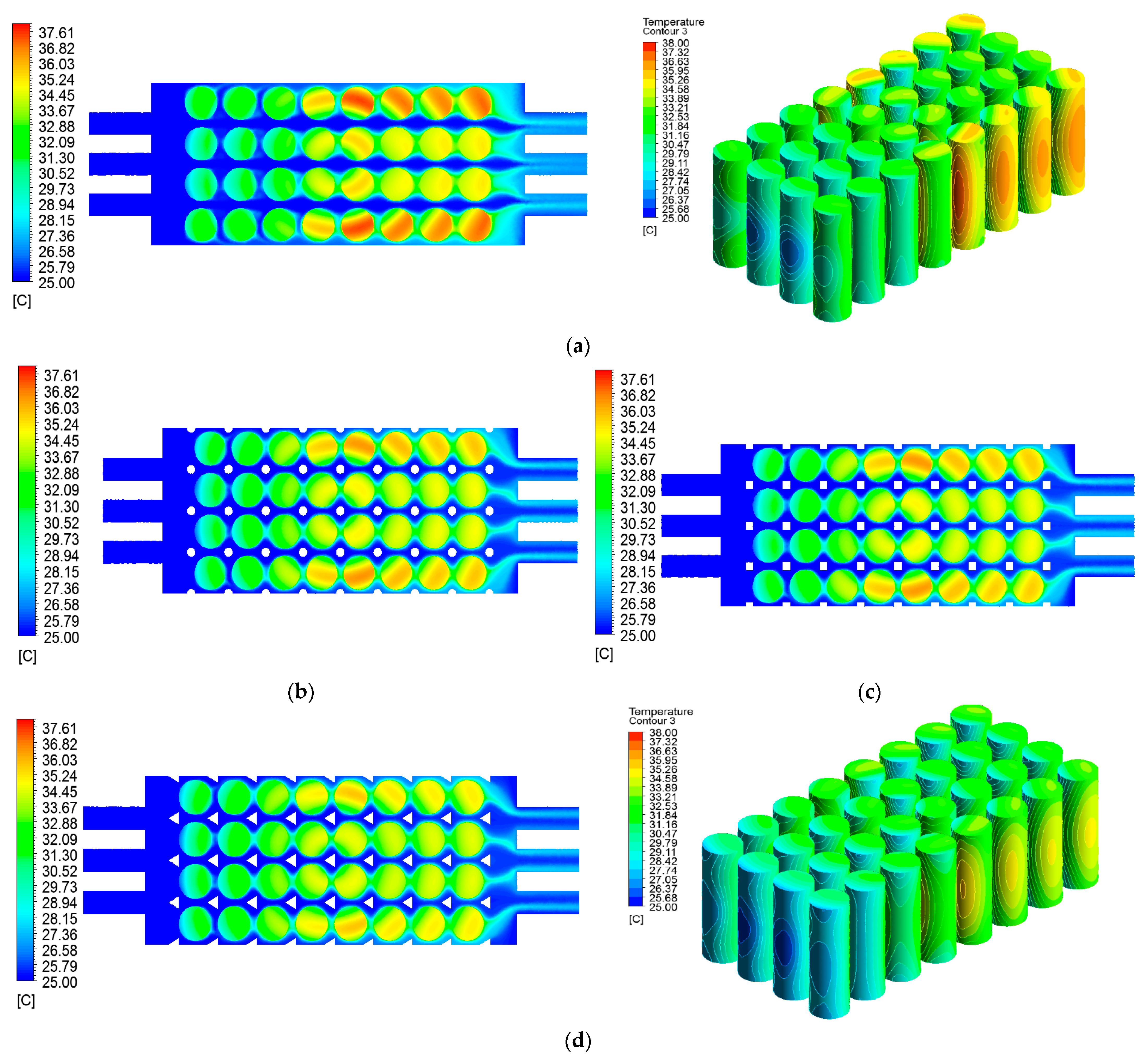

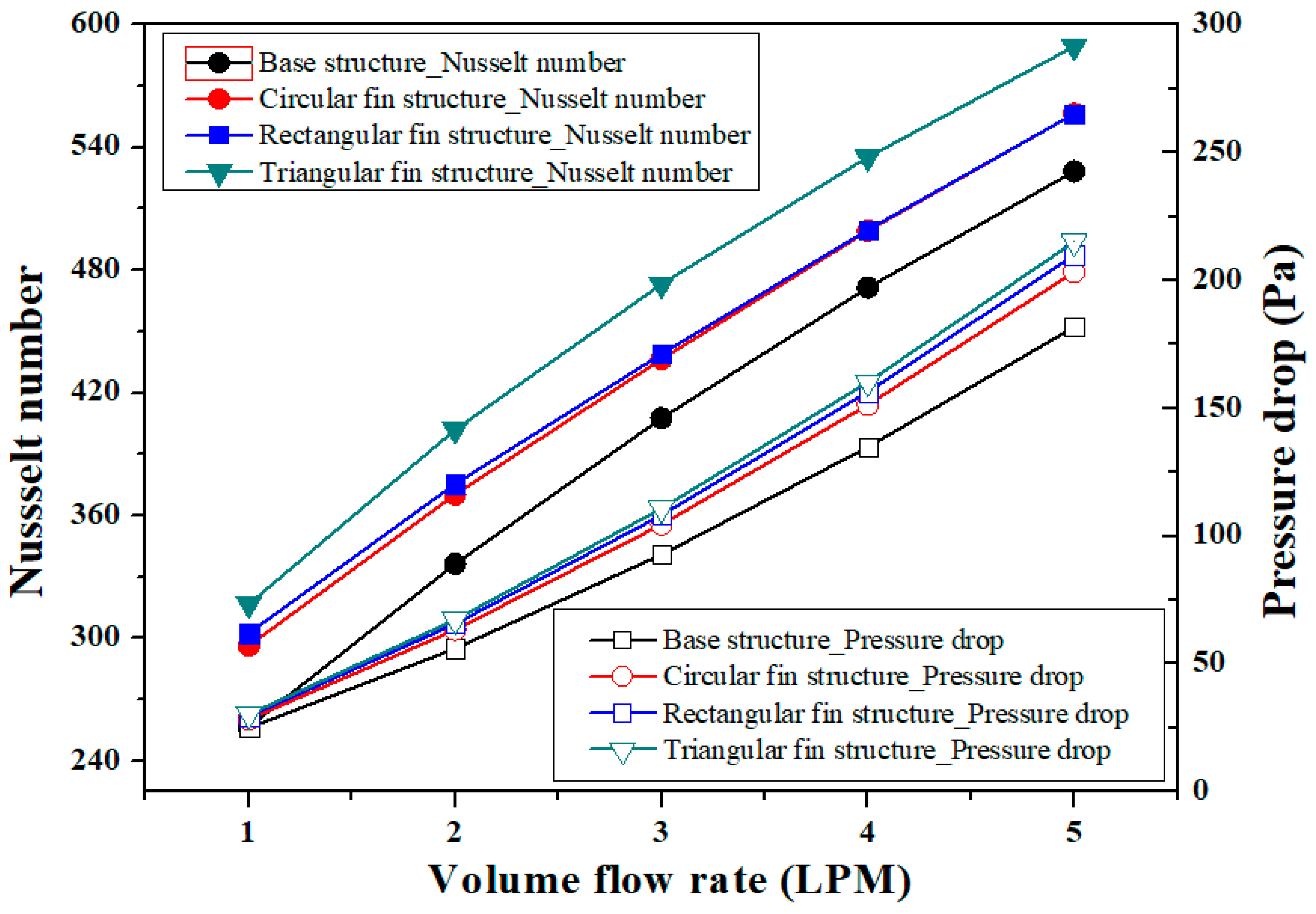
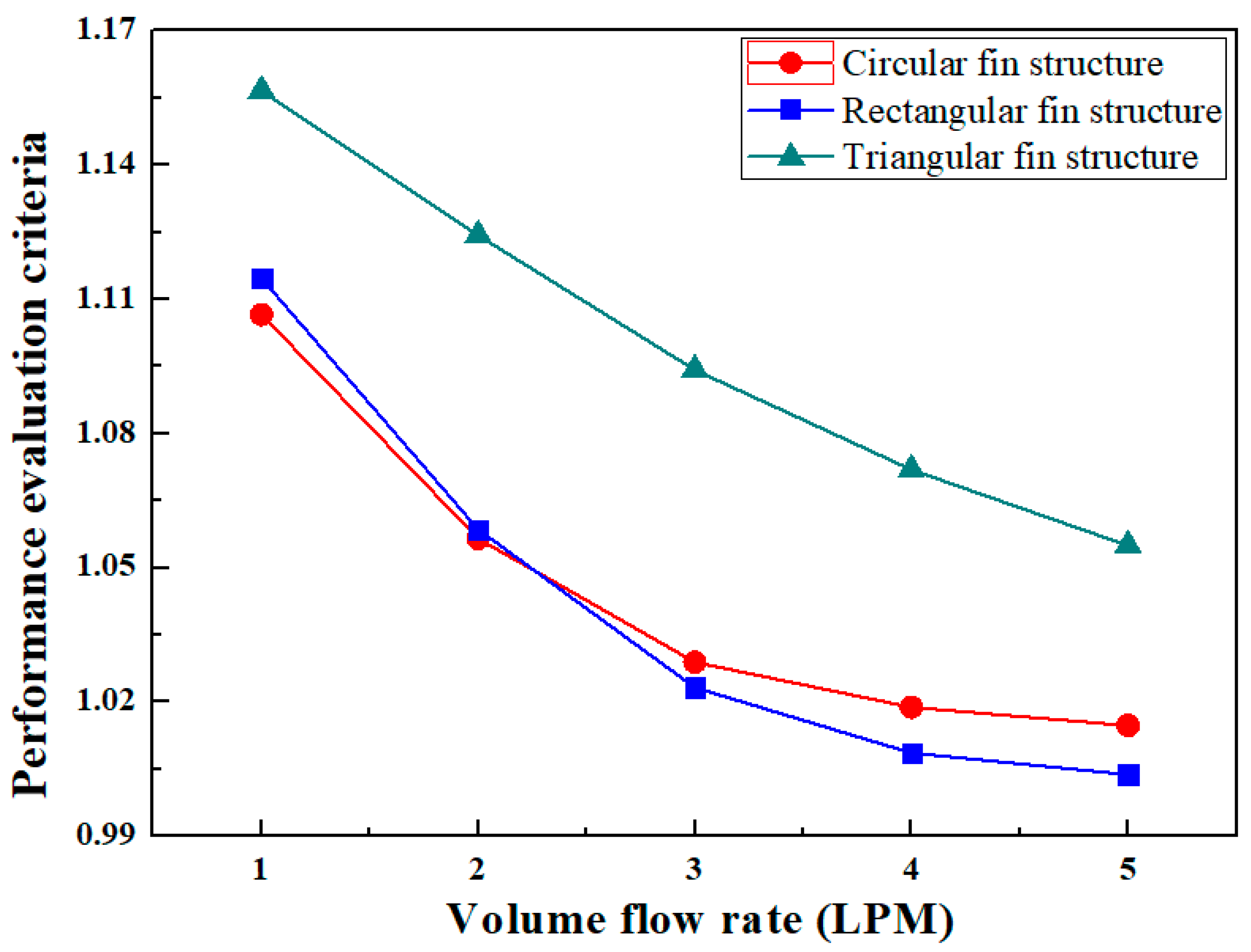

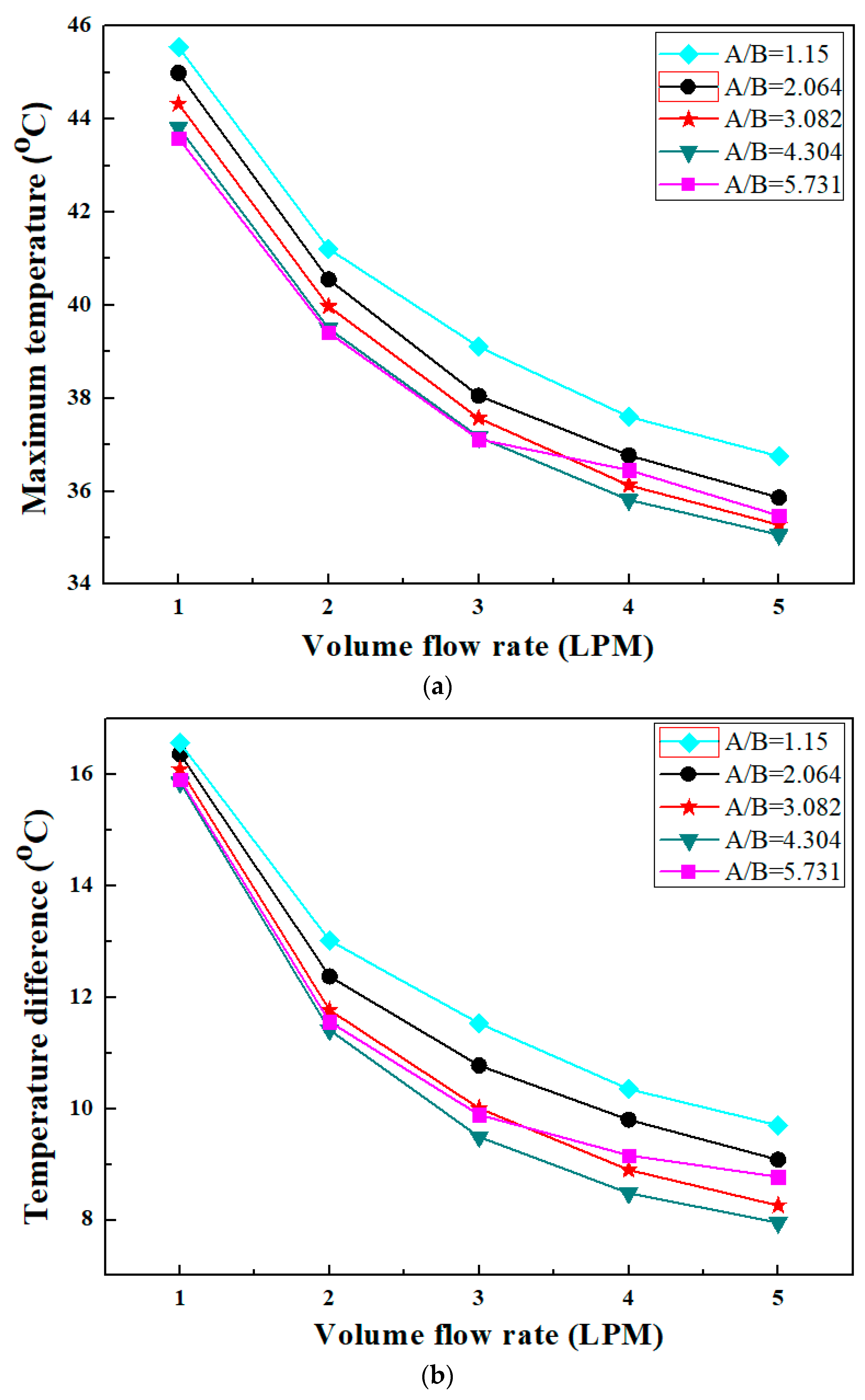
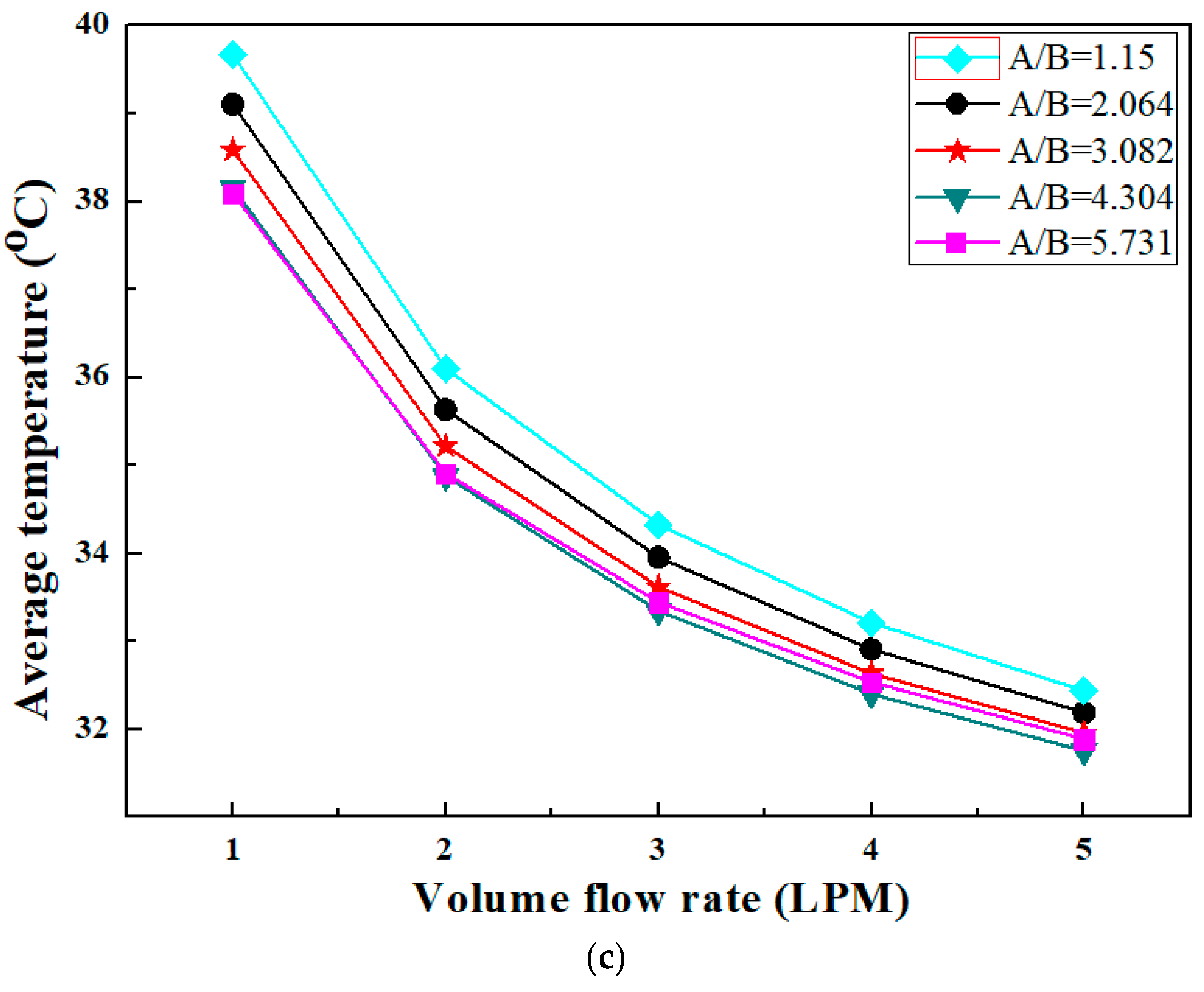
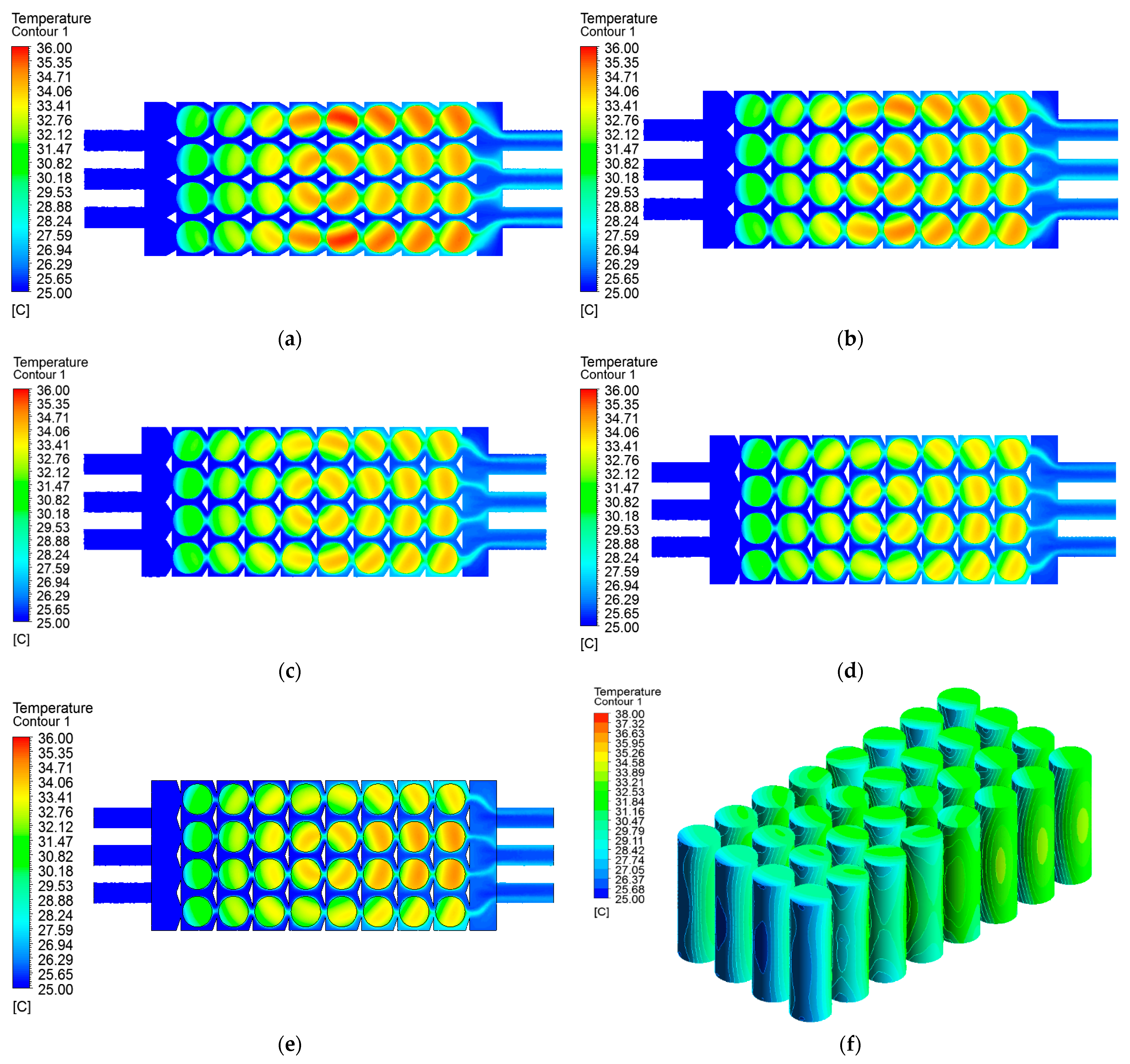


| Mesh Type | Number of Elements | Maximum Temperature (°C) | Pressure Drop (Pa) |
|---|---|---|---|
| Type 1 | 1,917,896 | 48.22 | 23.92 |
| Type 2 | 2,718,920 | 48.46 | 24.36 |
| Type 3 | 3,719,946 | 48.82 | 24.67 |
| Type 4 | 5,313,376 | 49.14 | 24.93 |
| Type 5 | 6,239,514 | 49.22 | 25.02 |
| Type 6 | 6,772,943 | 49.24 | 25.09 |
| Authors | Configuration | Results |
|---|---|---|
| Sundin et al. [19] | 68 Ah battery cell with single phase immersion cooling | 30 °C at 2C discharge rate |
| Li et al. [21] | 18650 lithium-ion battery cell (Single cell) with phase change immersion cooling | 34.5 °C at 7C discharge rate |
| Dubey et al. [22] | 21700 cylindrical battery pack with immersion cooling | 44 °C at 2C discharge rate |
| Patil et al. [27] | 50 V battery pack (pouch cell), immersion cooling with baffles | At 3C discharge rate, 31.7 °C for 3 LPM 28 °C for 10 LPM |
| Le et al. [28] | Lithium-ion battery pack, immersion cooling with baffles | 35.06 °C at 5C discharge rate for optimized structure |
| Present study | 18650 lithium-ion battery pack, immersion cooling, fin structures | 35.07 °C at 5C discharge rate for best fin structure |
Disclaimer/Publisher’s Note: The statements, opinions and data contained in all publications are solely those of the individual author(s) and contributor(s) and not of MDPI and/or the editor(s). MDPI and/or the editor(s) disclaim responsibility for any injury to people or property resulting from any ideas, methods, instructions or products referred to in the content. |
© 2022 by the authors. Licensee MDPI, Basel, Switzerland. This article is an open access article distributed under the terms and conditions of the Creative Commons Attribution (CC BY) license (https://creativecommons.org/licenses/by/4.0/).
Share and Cite
Han, J.-W.; Garud, K.S.; Kang, E.-H.; Lee, M.-Y. Numerical Study on Heat Transfer Characteristics of Dielectric Fluid Immersion Cooling with Fin Structures for Lithium-Ion Batteries. Symmetry 2023, 15, 92. https://doi.org/10.3390/sym15010092
Han J-W, Garud KS, Kang E-H, Lee M-Y. Numerical Study on Heat Transfer Characteristics of Dielectric Fluid Immersion Cooling with Fin Structures for Lithium-Ion Batteries. Symmetry. 2023; 15(1):92. https://doi.org/10.3390/sym15010092
Chicago/Turabian StyleHan, Jeong-Woo, Kunal Sandip Garud, Eun-Hyeok Kang, and Moo-Yeon Lee. 2023. "Numerical Study on Heat Transfer Characteristics of Dielectric Fluid Immersion Cooling with Fin Structures for Lithium-Ion Batteries" Symmetry 15, no. 1: 92. https://doi.org/10.3390/sym15010092
APA StyleHan, J.-W., Garud, K. S., Kang, E.-H., & Lee, M.-Y. (2023). Numerical Study on Heat Transfer Characteristics of Dielectric Fluid Immersion Cooling with Fin Structures for Lithium-Ion Batteries. Symmetry, 15(1), 92. https://doi.org/10.3390/sym15010092







